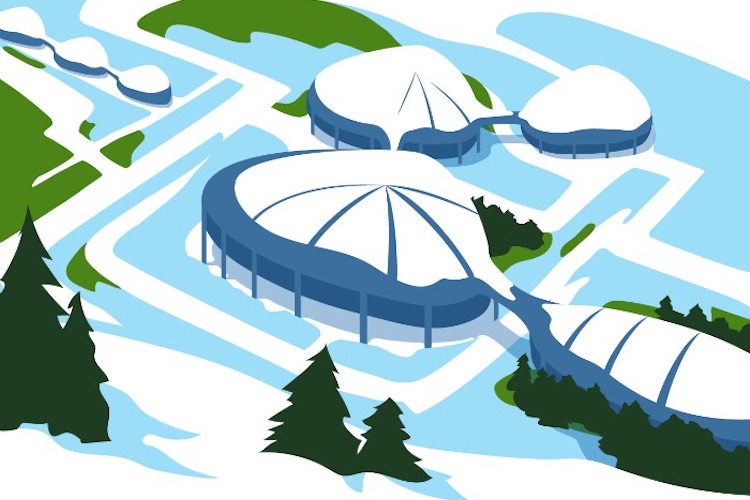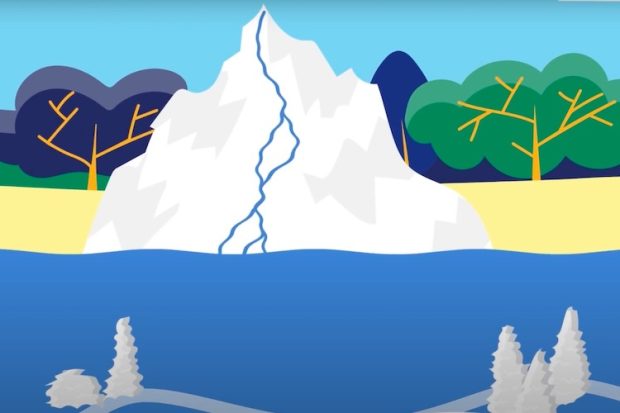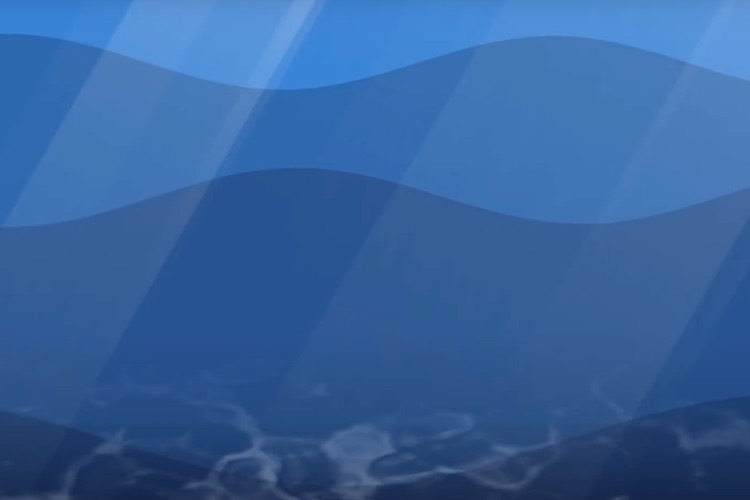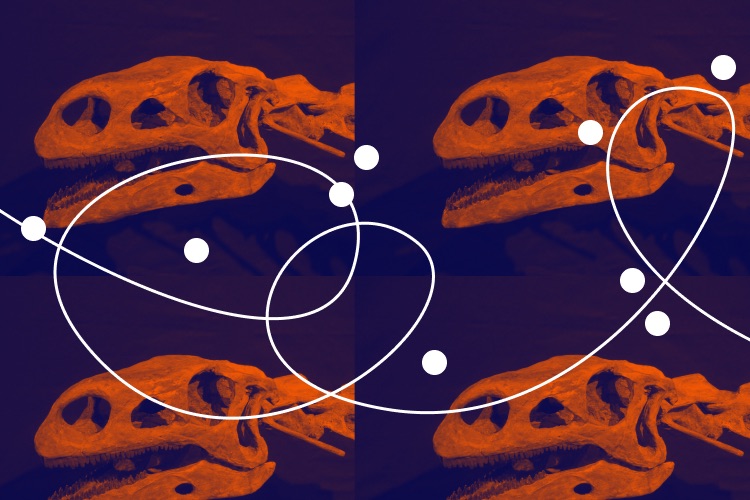Ice Ages
Geologist Philip Gibbard on Louis Agassiz, the Quaternary, and the Effects of Global Warming
faq | July 26, 2016

In Earth’s history, there are long periods of warm climate when the Earth was warm all the way from the equator to the poles. And then in other parts of Earth’s history, there appear to be cold periods in which glaciation reached the regions which are currently temperate. And these seem to have happened periodically. We are living in an ice age at the moment, but there were long periods in the past when there was relatively little ice. There has probably always been some ice, but it’s been limited, perhaps, to mountains or polar regions. The important thing about ice ages is that they change the character of the Earth’s surface. Each glaciation changes the Earth’s appearance. It may be subtle, small changes each time, but there is a progressive change.
Ice Ages Throughout History
We don’t know precisely how many ice ages have occurred in Earth’s history, but we do know that there have been at least five, and possibly as many, as seven major ice ages, starting in the period we call the Precambrian. There was a major period of glaciation and ice age which you may have heard of called the “Snowball Earth”. That was about 700 million years ago, and at that time, there was considerable extensive glaciation of the Earth’s surface. The next glaciation occurred in the period we call the Ordovician about 450 million years ago. And then there was a very major ice age called the Permo-Carboniferous Glaciation which occurred on the southern continents, often called Gondwanaland, when they were arranged around the South Pole. Those continents were Antarctica, Australia, South America, India, and Africa, and there are glacial deposits covering extensive regions that date from that period, about 300 million years ago.
The most recent glaciation is the one we are living in now, but to say when it began is a little bit problematic. It didn’t begin all at once, it was progressive, so the first evidence of glaciation we have is about 50 million years ago in Antarctica. However, the major Ice Age which we are living in now (the Quaternary) really started, as far as we’re concerned when glaciers in the northern hemisphere reached the sea about 2.5 million years ago. And we’re still living in that ice age.
In addition, the structure of each ice age appears to be periodic. There are short periods of relatively warm conditions and then longer periods during which we seem to have glaciation. And the cold periods are not just a result of glaciation, of course. Glaciation is the most spectacular consequence of these cold periods, but there are also substantial intervals that are not glacial but still very cold. And today, we would point to areas like Alaska or Siberia, where it can get very cold in the winter but where there’s no glaciation because there isn’t sufficient precipitation to provide a source of water for glaciers.
Discovering Ice Ages
We’ve known about ice ages on Earth since the mid-nineteenth century. Various people have been credited with the realization, but the name that’s usually associated with ice ages is Louis Agassiz, who’s a Swiss geologist from the mid-nineteenth century. He looked at glaciers in the Alps and realized that they were once much more extensive than they are today. But he wasn’t really the first. There were others in Switzerland; someone called Jean de Charpentier had already noticed this as well.

As geological mapping began, particularly in northern Europe, it was realized that glaciers had once been very extensive indeed. In the past, there was a lot of discussion about how this related to Noah’s flood because there was a conflict between the geological evidence and the Bible, Biblical teachings. And initially, people called these glacial deposits that were found drift deposits or diluvial deposits because they thought they were evidence of Noah’s flood. It was later found that this explanation didn’t hold, and, in fact, they were evidence of cold climates and more extensive glaciation. So by the beginning of the 20th century, it was realized that there were multiple glaciations, not just one, and then, subsequently, everything developed from there.
Researching Ice Ages
There is geological evidence of ice ages. The main evidence for glaciation is from particularly characteristic sediments which are formed by glaciers, and they’re preserved in the geological record. They can be found in the form of thick sequences of characteristic sediments called diamicton. They are just glacial deposits, but glacial deposits include not only sediments directly from the glacier but also from meltwater sediments formed by meltwater streams or glacial lakes or from where the glaciers were floating in the sea.
There are various forms of glacial lakes, but, in principle, the basic difference is that they are water bodies that are dammed by ice, so, for example, if you have a glacier that advances up a river valley, it blocks the valley rather in the way that you put a cork in a bottle. And, of course, when the ice blocks the valley, the river will still flow, and the water level will rise until it spills over. So a glacial lake is formed by being indirectly in contact with the ice, and there are characteristic sediments that such lakes contain and we can identify.
Because of the way that glaciers melt, which is controlled mostly by seasonal changes in temperature, you get annual discharge from the ice, and that gives you annual inputs of fine sediments derived from under the ice into the lakes. If we then look at the lakes, we get what is called laminated sediments, or rhythmically laminated sediments, which are also called by the Swedish word varve, which means annual deposition. So we can actually see annually laminated sediments in the glacial lakes, and we can even count those varves and figure out how long the lake existed. So we can, in fact, do a lot with such materials.
Now, if you think about Antarctica, you have large ice shelves where the ice goes off the land and onto the sea. And, of course, the ice is buoyant, so it floats, and as it floats, it carries with it pebbles and finer sediment material. But because of the heating effects of the water, the ice melts and, therefore, drops that material. That forms so-called ice-rafted detritus, which is dropped into the oceans. So when we see the fossil record of these periods, we can learn, by looking at these sediments and their associated landforms, where the glaciers were, how far they extended, and so on.
The Causes of the Ice Ages
Scientists believe that the ice ages occur because the Earth’s climate is controlled by the differential heating of its surface from the Sun. So, for example, equatorial regions where the Sun is almost vertically overhead are the warmest areas, and the polar regions where the Sun is at an extreme angle to the surface are the coldest. That means this differential in heating of the surface drives the ocean-atmosphere machine, which is trying all the time to transfer heat from the equatorial regions to the poles.
If the Earth were a simple globe, the transfer would be very efficient, and there would be a very small contrast between the equator and the poles. That’s happened in the past. But because we have continents, they get in the way of this circulation, and accordingly, the circulation patterns become very complicated. The simple patterns become inhibited and modified by the land and, in particular, the mountains, which causes the pattern of circulation which we see today, driving the trade winds or the ocean currents. For example, one of the concepts of why the ice ages began when they did, 2.5 million years ago, is associated with the rise of the Himalayan mountains. The Himalayas are still rising very rapidly, and it appears that the presence of those mountains in what is otherwise a very warm part of the Earth drives things like the monsoon system. The initiation of the Quaternary ice age is also associated with the closure of the Panama Isthmus, which links North and South America and therefore prevents ocean heat transfer from the equatorial Pacific to the Atlantic Ocean.
Now, if the position of the continents relative to each other and relative to the equator and the poles are such that the circulation works very effectively, the poles are warm, and we get relatively warm conditions all over the surface of the Earth. This is because the amount of heat that the Earth receives is basically constant and varies only a small amount. But if, like now, we have the continents forming very large barriers to the north-south circulation pattern, we get a very strongly zoned climate. That means the poles are relatively cold, and the equatorial regions are warm. If that happens, as we have now, the Earth can be affected by the variation in Solar heating which it receives.

This gives rise to changes in cyclic patterns of climate change through the ice age. Glaciations tend to occur in these cyclic patterns of 100 000 years. The last interglacial period, which was warm like now, was 125 000 years ago, and then there was a long glacial period which was about 100 000 years long, and now we’re living in another interglacial period. And that interglacial period is likely not to last forever, so we are likely to go back into a period of glaciation in the future.
Reasons Ice Ages End
In the short term, the orbital changes alter the climate, and it appears that the ice ages are characterized by this alternation of cold events, which last anything up to 100 000 years, and warmer events. We call them glacials and interglacials. We are living today in an interglacial, and an interglacial is characterized by the sort of conditions we see today – high sea level, limited glaciation, etc.. There’s still glaciation, of course, in Antarctica, Greenland, and other places like that. But there are also relatively warm conditions. That’s an interglacial: high sea levels, warm conditions, and a generally equitable climate.
But during the glacial periods, the mean annual temperatures change considerably, and vegetation belts are forced to move south or north depending on whether you are in the northern or southern hemispheres. Areas like Cambridge or Moscow become uninhabitable, at least in the winter, though they may be habitable in summer because of strong seasonal contrast. But what happens, basically, is that the cold areas expand considerably, mean annual temperatures go down, and we get very cold conditions indeed. And while the big glacial events are relatively limited in time, possibly just 10 000 years, these long cold periods can be 100 000 years or more. So that’s the glacial-interglacial cyclicity.
As regards the long term, it is impossible to say when we are going to come out of the glaciation. It’s conditioned by plate tectonics, the positions of the continents on the surface of the Earth. So at the moment, the North Pole and the South Pole are isolated; Antarctica is on the South Pole, and the Arctic Ocean is at the North, so there’s this heat circulation problem. And until the distribution of the land changes, this ice age regime can be expected to continue. Looking at long-term plate tectonic change, predictions suggest that it may be as long as 50 million years into the future before significant changes occur that will allow the Earth to emerge from the current ‘glacial’ state.
Geological Consequences
One of the biggest consequences of ice ages is that when there are large ice sheets, you have to ask yourself: where does the water come from? And the water, of course, comes from the oceans. What happens during an ice age is that glaciers build up as a consequence of precipitation on the land, but because the water is not returned to the oceans, sea levels fall. Thus during the main periods of glaciation, the ocean levels dropped by over 100 meters.
That exposes large areas of continental shelves which are drowned today. So it would mean, for example, that you could walk from Britain to France. But you could also walk from New Guinea to Southeast Asia, the continent, and similar large areas. And one of the main critical points linking Alaska, across the Bering Strait, to easternmost Siberia is relatively shallow, only about 40 meters, so if the sea level goes down about 100 meters, then that area becomes land. That is very significant, not just because it’s land but because plants and animals can migrate across these areas and enter into regions that today would be barriers. So the colonization of North America depends on the existence of the so-called Bering Land Bridge.
Animals: Surviving the Ice Age, But Not Human Activity
It’s important to remember that we ourselves are products of the ice age; we’ve evolved during the ice age, so we can survive it. However, it’s not just about individual people; it’s about population. The problem today is that there are far too many of us, and our activities have substantially modified natural conditions. Under natural conditions, the plants and animals we see today, many of which have very long histories, have survived the ice age perfectly well, though some have done so with some minor evolution. What they do is migrate, adapt, and so on. There are areas where plants and animals survived the ice age, and these so-called refugial areas were further south or north than they are today.
And this sort of thing has happened on all the continents except, possibly, Africa. Great numbers of the larger members of the vertebrate fauna, particularly the mammals, but also, in Australia, the marsupials, have been driven to extinction by humans. This was caused either directly by our activities, hunting, or indirectly, by destroying their habitats. The creatures that live in the northern latitudes today lived in the past in the Mediterranean region. We’ve damaged that region to such an extent that it’s probably going to be very difficult for those plants and animals to recolonize it.
The Effects of Global Warming
Under normal conditions, we would go back into an ice age quite soon in geological terms. But because of global warming, which is a consequence of human activities, we are likely to delay that ice age. We won’t stop it from happening because the conditions which have caused ice ages in the past are still holding today. It’s just that the wildcard, the thing that’s changed, is human activity. It produces global warming and, in particular, atmospheric warming, which maybe has already caused the delay of the next glacial period.
In fact, climate change is a major worry and a major concern. It’s clear that if, for example, the Greenland ice cap were to melt, it would raise global sea levels by up to 6 meters. We know that in the past, for example, in the last interglacial period, which was about 125 000 years ago, the Greenland ice cap was largely melted, and sea levels reached as much as 4 to 6 meters above present. This is not something that we have to consider the end of the world. It is not merely a temporary blip, but the Earth has recovered from disasters before, and it will recover from this one. So the long-term prognosis is good, but the long-term prognosis for humans – that’s a different issue.
The critical point, however, is that we are moving towards trying to understand the way the planet is evolving and the way that the climate and ocean systems operate. The more research we do and the better our understanding of the rates of change and impacts of those changes, the more we are getting into a position of understanding the planet we live on. This is important because humans are finally beginning to worry about sea-level rise, global warming, and the impact those things will have on agriculture and on population, and all of that, in part, comes from this research on ice ages. These investigations are providing us with the tools which, hopefully, we can use to be proactive in trying to alleviate some of the changes which we are bringing about ourselves. This is one of the major results and the major goals of ice-age research.
Edited by Alina Shubina






























